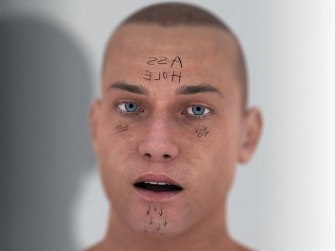 |
| Ed Atkins, Ribbons, 2014 |
British wonderboy Ed Atkins has an
installation at the Palais de Tokyo that anyone who claims to keep up with the
art world will need to see. At 32, Atkins has made quite an impression on those
who matter with exhibitions at MoMA, a single artist show at the Serpentine’s
Sackler Gallery, a solo exhibit at the Tate Modern, the ICA, Venice, and the
list goes on. The impressive CV was enough to entice Irina and I to see Bastards following our visit next door
to what was, by comparison, the genteel Fontana exhibition.
 |
| Ed Atkins, Ribbons, 2014 |
Ribbons (2014), adapted for the Palais de Tokyo, is a three channel, high
definition video installation in which Atkins explores the latest language in
image production. Morphing between filmed footage and digital imagery, Atkins
uses everything from traditional video and cinematic strategies —blurring,
lens-flares, scratches, sound and image editing — to the latest computer
graphics for which he apparently does all his own coding. There’s no doubt that
the technical dimension of Atkins work is inspiring. His command of the image
and its multi-form production is impressive, speaking to the agility of image
integration and technical literacy of his generation. Likewise the form is
exciting in its reflection of the way that we receive and process visual
information.
 |
| Ed Atkins, Ribbons, 2014 |
Irina and I, two women of a different
generation, may not have been able to identify with or in the images, but both
of us were convinced that Atkins’ Ribbons
was more relevant and more interesting than Godard’s latest film, Adieu au Language (2014), a film we had
seen the week before. Atkins, unlike Godard who claims to converse with the
latest image technology, actually uses the most contemporary visual and sonic
language as he moves in and out of as well as along a spectrum of digital
possibilities. Atkins creates a more convincing adieu to language than Godard’s
soporific dabble with 3D imaging. Words for Atkins are text messages, made
visual before disappearing to be replaced by the next words or image, they are
reduced to marginalia, scribbles on a body, snatches of poetry, quotations
emptied of meaning, unfinished.
 |
| Ed Atkins, Ribbons, 2014 |
The protagonist — who seems to shift in and
out of identification with Atkins is a troll, apparently. But mostly, he is
obsessed with his sexuality, distractedly getting involved with those great
British pastimes — getting drunk and falling over—until he is deflated,
literally, through computer generated animation. The Palais de Tokyo identified
the character in the three narratives, on three large discrete screens, his
voice resonating through the space, as Atkins. But it isn’t, it’s an actor.
Admittedly though, the identity of the actor is not important, in fact, the
confusion of identity reinforces the anonymity of the artist. It might as well
be Atkins, his alter ego, bellowing with pride and then deflated, defaced or
effaced. He is often surrounded by pint glasses, pouring drinks, being drunk,
getting high, sticking his tongue, his nose, then later, his penis through a
hole, wedging himself under the table. It is all about Atkins even if he is not
in the videos.
 |
| Ed Atkins, Ribbons, 2014 |
The sound for the exhibition was brilliant.
When Bach’s St Matthew’s Passion was sung, the three voices resonated and
intertwined through the sound of the three different screens. And then, at
other times, we are completely surrounded by the sound when standing before the
screen to which it relates, and there is no interruption of the sound from the
other screens. Bach mutates into burps and farts and then Randy Newman who is,
in turn, interrupted by email alerts.
If technically Atkins’ installation is
brilliant, even mesmerizing, conceptually it lacks maturity. We also become
aware of Atkins’ identity through the musings and convolutions of sound and
image. With his obsessions of drinking, speaking, fucking, with an occasional
search for reality, Ribbons comes
across as the work of a young, ego-centric heterosexual artist who does not yet
have the depth to allow for the resonance and profundity of those he quotes,
such as Blanchot and Lacan. As captivating as it was, the irony wasn’t strong
enough to convince me that this is anything but a straight boy’s glib view of
the world. Atkins could develop his work in a number of different directions,
and his success as an artist will depend on which of these he chooses. But for the
moment, to me, he’s still a 32 year old young man with work to do.
All Images Courtesy of the Artist
No comments:
Post a Comment